Tetramorium mars
| Tetramorium mars | |
|---|---|

| |
| Scientific classification | |
| Kingdom: | Animalia |
| Phylum: | Arthropoda |
| Class: | Insecta |
| Order: | Hymenoptera |
| Family: | Formicidae |
| Subfamily: | Myrmicinae |
| Tribe: | Crematogastrini |
| Genus: | Tetramorium |
| Species group: | plesiarum |
| Species: | T. mars |
| Binomial name | |
| Tetramorium mars Hita Garcia & Fisher, 2014 | |
The new species was mainly sampled by litter extraction or pitfall trapping, which suggests a ground active lifestyle. Interestingly, T. mars was not found in Andohahela in the southeast of Madagascar, even though Tetramorium bressleri, Tetramorium hobbit, and Tetramorium plesiarum occur there. This is surprising since the four species of the group except Tetramorium gollum share more or less the same distribution range.
Identification
A member of the Tetramorium plesiarum species group. Hita Garcia and Fisher (2014) - Tetramorium mars is distinguishable from the other group members by the following combination of characters: antennal scapes very short (SI 58–62); petiolar node never enlarged and massive; node in profile high, rectangular, blocky nodiform with well-defined antero- and posterodorsal margins; anterodorsal margin not protruding anteriorly nor very sharply angled; petiolar node in profile relatively low, between 1.3 to 1.5 times higher than long (LPeI 69–76), in dorsal view only 1.1 to 1.2 times wider than long (DPeI 108–123); gaster never enlarged or swollen; ground sculpture on head and mesosoma weak to absent; first gastral tergite without strong reticulate-rugose sculpture, usually completely unsculptured, but if sculpture present, then relatively weak and restricted to base of tergite; pilosity on first gastral tergite mostly erect.
Within the species group T. mars is not likely to be confused with the other five species. The lack of strong and conspicuous sculpture on the basal half of the first gastral tergite, an enlarged gaster, and the lower and less broad petiolar node separate T. mars (LPeI 69–76; DPeI 108–123) clearly from Tetramorium gollum (LPeI 57–60; DPeI 130–148). Despite the fact that T. mars shares some similarities with Tetramorium bressleri and Tetramorium plesiarum, the latter also have relatively higher, thinner, and wider petiolar nodes (LPeI 56–63; DPeI 130–144) which distinguish them from T. mars. In addition, T. mars has much better developed sculpture on the dorsum of the petiolar node than T. bressleri or T. plesiarum. The species most similar morphologically to T. mars is Tetramorium hobbit. Both share a more blocky nodiform petiolar node, but which is still much larger in T. hobbit. Indeed, this massively developed node, in combination with very conspicuous punctate ground sculpture on head and mesosoma, separates T. hobbit from T. mars, which has a much smaller petiolar node and only weakly developed ground sculpture on head and mesosoma. Further characters that distinguish T. mars are the comparatively short antennal scapes (SI 58–62 vs. SI 64–67) and smaller body size (HW 0.69–0.74 vs. HW 0.80–0.88).
Despite its relatively broad distribution range, T. mars displays very little intraspecific or geographic variation.
Keys including this Species
Distribution
Tetramorium mars has a broad distribution in western Madagascar. It ranges from the southernmost known localities, Beza-Mahafaly and Forêt de Mite, through Kirindy Mite and Tsingy de Bemaraha to the northernmost localities, Baie de Baly and Ankarafantsika.
Latitudinal Distribution Pattern
Latitudinal Range: -16.01° to -23.6865°.
| North Temperate |
North Subtropical |
Tropical | South Subtropical |
South Temperate |
- Source: AntMaps
Distribution based on Regional Taxon Lists
Malagasy Region: Madagascar (type locality).
Distribution based on AntMaps
Distribution based on AntWeb specimens
Check data from AntWeb
Countries Occupied
| Number of countries occupied by this species based on AntWiki Regional Taxon Lists. In general, fewer countries occupied indicates a narrower range, while more countries indicates a more widespread species. |

|
Estimated Abundance
| Relative abundance based on number of AntMaps records per species (this species within the purple bar). Fewer records (to the left) indicates a less abundant/encountered species while more records (to the right) indicates more abundant/encountered species. |

|
Habitat
All known localities are tropical dry or gallery forests at low elevations from 10 to 165 m.
Biology
Castes
Images from AntWeb
 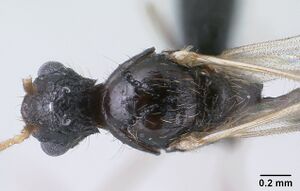  
| |
| Male (alate). Specimen code casent0134555. Photographer Dimby Raharinjanahary, uploaded by California Academy of Sciences. | Owned by CAS, San Francisco, CA, USA. |
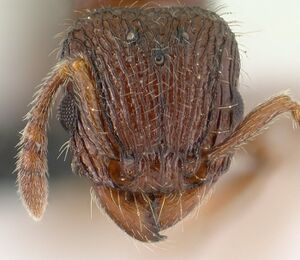  
| |
| Queen (alate/dealate). Specimen code casent0134584. Photographer Dimby Raharinjanahary, uploaded by California Academy of Sciences. | Owned by CAS, San Francisco, CA, USA. |
 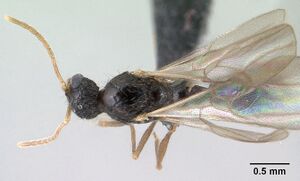 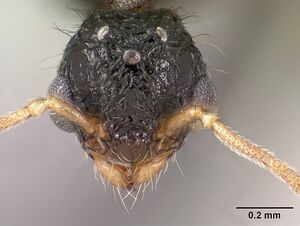 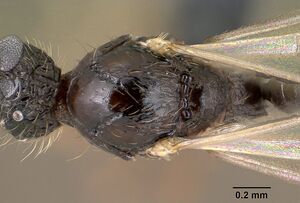   
| |
| Male (alate). Specimen code casent0144888. Photographer Dimby Raharinjanahary, uploaded by California Academy of Sciences. | Owned by CAS, San Francisco, CA, USA. |
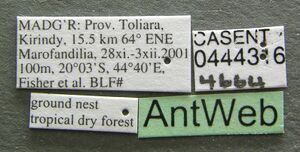 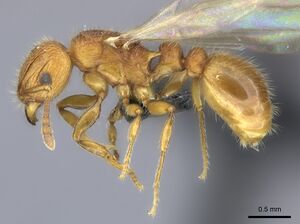 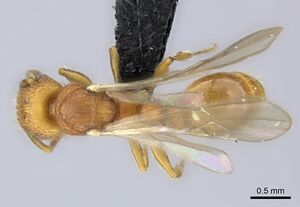  
| |
| Queen (alate/dealate). Specimen code casent0444316. Photographer Estella Ortega, uploaded by California Academy of Sciences. | Owned by CAS, San Francisco, CA, USA. |
  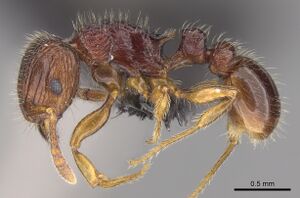 
| |
| Holotype of Tetramorium mars. Worker. Specimen code casent0474279. Photographer Cerise Chen, uploaded by California Academy of Sciences. | Owned by CAS, San Francisco, CA, USA. |
Nomenclature
The following information is derived from Barry Bolton's Online Catalogue of the Ants of the World.
- mars. Tetramorium mars Hita Garcia & Fisher, 2014: 46, figs. 10B, 12B, 13A, 18, 62 (w.) MADAGASCAR.
Unless otherwise noted the text for the remainder of this section is reported from the publication that includes the original description.
Description
Worker
(N=12). HL 0.71–0.77 (0.74); HW 0.69–0.74 (0.72); SL 0.42–0.46 (0.44); EL 0.15–0.17 (0.16); PH 0.35–0.44 (0.38); PW 0.50–0.58 (0.54); WL 0.83–0.96 (0.88); PSL 0.21–0.24 (0.22); PTL 0.22–0.27 (0.24); PTH 0.32–0.37 (0.34); PTW 0.26–0.33 (0.29); PPL 0.22–0.26 (0.24); PPH 0.28–0.33 (0.31); PPW 0.36–0.42 (0.38); CI 96–99 (98); SI 58–62 (60); OI 21–22 (22); DMI 60–64 (62); LMI 42–46 (44); PSLI 28–32 (30); PeNI 51–56 (53); LPeI 69–76 (73); DPeI 108–123 (117); PpNI 68–72 (70); LPpI 75–80 (78); DPpI 156–165 (160); PPI 129–137 (134).
Head longer than wide (CI 96–98); posterior head margin weakly concave. Anterior clypeal margin with distinct median impression. Frontal carinae strongly developed and forming dorsal margin of very well-developed antennal scrobes, scrobes moderately to very deep and with clearly defined margins all around; median scrobal carina very well developed and distinctly surpassing posterior eye level. Antennal scapes very short, not reaching posterior head margin (SI 58–62). Eyes relatively small to moderate (OI 21–22). Mesosomal outline in profile moderately convex, rounded and high (LMI 42–46), moderately to strongly marginate from lateral to dorsal mesosoma; promesonotal suture and metanotal groove absent. Propodeal spines long, elongate-triangular to spinose (PSLI 28–32), spines always with broad base and acute tip; propodeal lobes well developed, elongate-triangular, and acute, always much shorter than propodeal spines. Petiolar node in profile high, rectangular, blocky nodiform with well-defined antero- and posterodorsal margins, between 1.3 to 1.5 times higher than long (LPeI 68–76), anterior and posterior faces approximately parallel, antero- and posterodorsal margins situated at about same height, petiolar dorsum weakly convex; node in dorsal view around 1.1 to 1.2 times wider than long (DPeI 108–123), in dorsal view pronotum between 1.8 to 2.0 times wider than petiolar node (PeNI 51–56). Postpetiole in profile subglobular, approximately 1.3 times higher than long (LPpI 75–80); in dorsal view around 1.5 to 1.7 times wider than long (DPpI 156–165), pronotum around 1.4 to 1.5 times wider than postpetiole (PpNI 68–72). Postpetiole in profile appearing much less voluminous than petiolar node, postpetiole in dorsal view around 1.3 to 1.4 times wider than petiolar node (PPI 129–137). Mandibles unsculptured, smooth, and shining; clypeus longitudinally rugose/rugulose, with five to seven distinct rugae/rugulae, median ruga better developed than remainder, all rugae without cross-meshes; cephalic dorsum between frontal carinae with eight to twelve longitudinal rugae, rugae running from posterior clypeal margin to posterior head margin, often interrupted or with cross-meshes, especially posteriorly; scrobal area mostly unsculptured; lateral head mainly longitudinally rugose. Ground sculpture on head generally weak to absent, sometimes a few areas weakly punctate. Mesosoma laterally irregularly longitudinally rugose with a few shining areas on mesopleuron and propodeum, mesosomal dorsum longitudinally rugose. Forecoxae unsculptured, smooth, and shining. Ground sculpture on mesosoma absent. In profile, basal half of petiolar node mostly unsculptured, upper half distinctly reticulate-rugose, whole dorsum of node distinctly reticulate-rugose; sculpture on postpetiole much more weakly developed, laterally and dorsally weakly irregularly rugulose. Ground sculpture on waist segments variable, usually weak or absent, often petiole and/or postpetiole conspicuously reticulate-punctate. Gaster usually unsculptured, smooth, and shining, sometimes base of first gastral tergite weakly punctate. Whole body with very abundant, long, and fine standing hairs; first gastral tergite with abundant, long, erect hairs and much scarcer, shorter, decumbent to subdecumbent hairs. Anterior edges of antennal scapes and dorsal (outer) surfaces of hind tibiae with decumbent to suberect hairs. Usually body uniformly light to reddish brown, sometimes darker.
Type Material
Holotype, pinned worker, MADAGASCAR, Toliara, Forêt de Kirindy, 15.5 km 64° ENE Marofandilia, 20.045°S, 44.6622°E, 100 m, tropical dry forest, sifted litter (leaf mold, rotten wood), BLF04605, 28.XI.2001 (B.L. Fisher et al.) (California Academy of Sciences: CASENT0474279). Paratypes, 24 pinned workers with same data as holotype (The Natural History Museum: CASENT0474298; CAS: CASENT0474278; CASENT0474281; CASENT0474287; CASENT0474289; CASENT0474292; CASENT0474294; CASENT0474304; CASENT0474310; CASENT0474312; CASENT0474322; CASENT0474328; CASENT0474331; CASENT0474335; CASENT0474338; CASENT0474345; CASENT0474347; CASENT0474349; CASENT0474354; CASENT0474357; CASENT0474366; CASENT0474371; Musee d'Histoire Naturelle Genève: CASENT0474312; Museum of Comparative Zoology: CASENT0474286; CASENT0474307).
Etymology
This new species is named after the ancient Roman god of war, “Mars”. The species epithet is an arbitrary combination of letters, thus invariable.
References
References based on Global Ant Biodiversity Informatics
- Blaimer B. B., S. G. Brady, T. R. Schultz, and B. L. Fisher. 2015. Fucntional and phylogenetic approaches reveal the evolution of diversity in a hyper diverse biota. Ecography 38: 001-012.
- Hita Garcia F, and B. L. Fisher. 2014. The hyper-diverse ant genus Tetramorium Mayr (Hymenoptera, Formicidae) in the Malagasy region - taxonomic revision of the T. naganum, T. plesiarum, T. schaufussii, and T. severini species groups. ZooKeys 413: 1-170.

